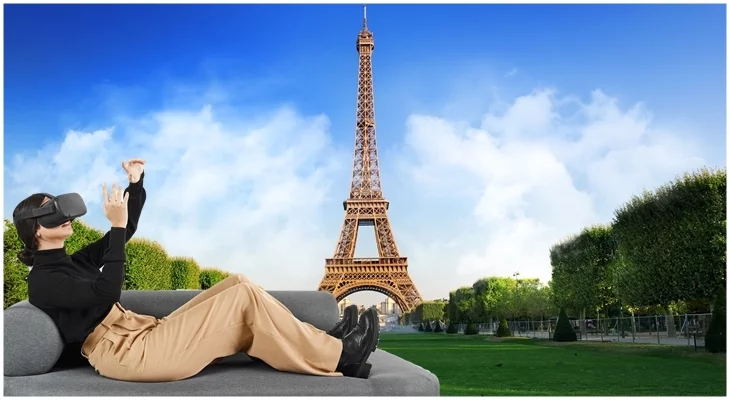Introduction to Virtual Reality in Tourism
Virtual reality in tourism provides viewers with an immersive tourism experience. There are many different types of virtual tourism services available. They use a combination of virtual reality, still images, video, audio, narration, and other multimedia formats.
It gives users an experience of a destination that they wouldn't get from looking at pictures or visiting a website.
Virtual tourism content can be accessed using a virtual reality headset for the most immersive experience. It can also be viewed on a regular computer or even a mobile device.
Virtual Reality in Tourism
Viewers can take part in activities, travel to different locations, and visit different destinations. They can do all this from the comfort of their own homes. Virtual tourism has many distinct advantages. The most obvious advantage is that viewers can see and experience a destination without having to travel there.
This means they are not restricted by available flights, travel logistics, safety concerns, or whether destinations are open. They aren't even concerned with time zones or weather conditions.
Another advantage for viewers is the cost
Millions of people who otherwise would not be able to afford to travel to these destinations can now do so. Viewers are embracing the rise of virtual tourism destinations to see and experience things they never imagined were possible.
The ability to read the minds of potential customers and highlight a location, amenities, and offerings is a clear benefit for hotels and destinations. Viewers who have been to a hotel or visited a location through virtual tourism are more likely to book a future stay. They also look forward to experiencing the activity in the “real world.”
Virtual tourism technology also provides excellent marketing opportunities. Instead of flat images on a brochure or website, potential guests can see a 360-degree view of a property and its amenities. Viewers who experience a property in this way are more likely to want to return in the future. They can also share the virtual offerings with their friends and family.
How is it used: Virtual Reality in Tourism?
There are many ways for hotels and destinations to enjoy this technology and the growing popularity of virtual tourism.
Virtual tourism has been in use for years to highlight the unique aspects of a location. These aspects can be history and culture to exciting activities, local attractions, and fun trivia.
360-degree VR video is used by hotels and local governments to capture everything about a destination in an immersive way. With the press of a button, viewers can travel to a remote mountaintop, a beautiful beach, a network of hiking trails, or a bustling city.
VR photography combines still images with specialized software
It creates an immersive image that allows the user to look in any direction. This technology is ideal for displaying hotel interiors, artwork, museum exhibits, and anything else that can be fully appreciated without the use of sound or motion.
Users can get in on the action with immersive VR experiences. They can interact with the environment and learn more through their actions. A curated experience focusing on one aspect of the location, such as the food scene, music, history, or art, is common. Virtual reality yoga classes, nature walks, stargazing, and bird watching are all popular ways to promote a location.
- Benefits of Virtual Reality in Tourism
- Before landing, passengers can take a 3D tour
- Virtual reality can aid in the planning of tourist attractions
- When there are delays in the travel schedule, travelers can use VR Tech
- Take a virtual reality tour of the plane
- Travel planners can use virtual reality to create engaging presentations
- Virtual reality is a fantastic way to advertise on social media
- Virtual reality can assist travelers in locating locations on a map
- Some Examples of Virtual Reality in Tourism
Benefits of Virtual Reality in Tourism
Before landing, passengers can take a 3D tour
There's nothing quite like knowing where you're going before you arrive at your destination. One of the benefits of virtual reality in tourism is that visitors can take a 3D tour of their destination before arriving. Virtual reality is distinct from traditional photography.
It allows users to immerse themselves in the experience. Tourists can thus sense a city's culture before ever setting foot in the city. It makes them feel less like outsiders when they arrive.
Virtual reality can aid in the planning of tourist attractions
Vacations always seem to be too short because visitors never get to see everything they want while on vacation. A lack of good planning is one of the reasons why key sights go unnoticed by tourists. Virtual reality allows visitors to learn the names and locations of all the town's major attractions ahead of time.
Tourists can also look inside famous landmarks to see if they want to take a virtual tour of them in real-time. Because virtual reality allows visitors to only entertain the locations that intrigue them the most in real-time, they get the most out of their sightseeing experience.
When there are delays in the travel schedule, travelers can use VR Tech
There's nothing worse than getting stranded at the airport for an unknown amount of time. During these times, boredom has a way of creeping in and clouding the vision of the excitement. When unexpected delays occur, the best way to re-establish excitement for the trip ahead is to take a virtual reality tour of the vacation destination.
Take a virtual reality tour of the plane
Some passengers feel more at ease after seeing the plane and knowing where all the emergency exits are located. Virtual reality allows passengers to take a 3D tour of the plane before boarding.
Travel planners can use virtual reality to create engaging presentations
The future of virtual reality in tourism does not completely end the need for actual tours. When it comes to presentations, travel planners should think about the advantages of virtual reality in tourism. Consider the coordinator who can do more than hand out a brochure listing possible locations.
How many more customers could a planner get if he could take them on a virtual tour of the streets of Venice before charging them for a trip they might or might not enjoy?
Virtual reality in tourism removes the element of surprise from travel. Thus ensuring that customers have a good time in their chosen destination.





